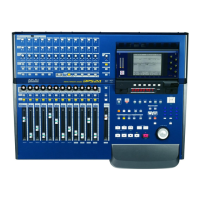12
Version 1.20 Addendum
USING AUTOMATED SCENE RECALL
Here are just a few things you can use automated scene recall for:
• Static EQ changes - change the settings of a channel’s EQ using scene recall at specific points in your
project. This is particularly useful if you have to have two different instruments on one track. For exam-
ple, on Track 5, you may have electric piano during the verses and strings during the chorus and each
need specific EQ settings. Store the EQ settings for each instrument in two different scenes and recall
them as appropriate.
• FX changes - change the selection of effects using scene recall at specific points in your project. Using
the above example of electric piano and strings sharing one track, the piano may require a chorus
effect and the strings a reverb effect. Store the different effects selection for each instrument in two
different scenes (along with the EQ settings for the channels!) and recall them as appropriate.
• FX settings - change the setting of effects parameters at specific points. For example, during the
chorus, you may want an instrument to have a delay time of 1,200ms but, in the chorus, you may want
this to be half of that. Store one scene with the effect at 1,200ms and another with the effect at 600ms
and recall them as appropriate.
• Static changes of controls such as pan and FX sends. Again, using the above example of electric piano
sharing a single track, you may want the piano panned to the left with a hint of chorus and the strings
panned to the right with a wash of reverb. Set each one as appropriate, store the settings for each in
two different scenes and recall them as appropriate.
• Completely re-configure your mix by recalling static fader settings. Although it is more likely you will use
gradually evolving, dynamic mixing, it can still be very useful to completely re-configure your fader
settings with a simple scene recall (especially in live applications where it is common to re-configure a
mix).
• Mute grouping - sometimes it might be necessary to mute several channels at once. Although this can
be achieved by recording individual channel mutes in several passes, a simpler way is to mute all the
channels you want to drop out and store that in a scene. At the appropriate moment, recall that scene
and all those channels will be muted.
For example, you want to mute channels 1, 2, 5, 6, 10, 14, 15, 16, 17, 21, 22, 23, 24 at a particular point
in the mix. As mentioned, you can record these mutes separately in several automation passes but this
takes time and, more importantly, it might be difficult to synchronise those mutes. A better method
would be to stop playback, mute those channels and store a scene. Then, at the appropriate moment,
recall that scene as part of the dynamic mix automation - the selected channels will be muted simulta-
neously. Recall another scene with those channels re-enabled.
• Static control changes of the MBCX - change the settings of the MBCX as the dynamic content of your
track changes. For example, the chorus might be quite bass heavy and require a certain combination
of settings whilst the verse is a little lighter in the LF region and so may require different settings. Store
each one in two different scenes and switch between them as appropriate.
These are just a few suggestions. No doubt you will find your own uses for automated scene recall accord-
ing to your circumstances and application.

